Irish musicians should consider themselves as being like highly trained sportspeople.
They participate in intermittent prolonged bouts of intense precision activity, requiring a lot of concentration.
They are likely to suffer injury from time to time related to playing their instruments. They can minimise their risk of injury.
Ideal posture w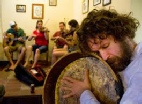 ould have the musician sitting comfortably on a seat at around knee height, with a backrest that does not limit movement of the shoulders – a narrow backed chair is ideal. The body should be held upright, tall and straight, with the weight equally balanced between left and right side.
ould have the musician sitting comfortably on a seat at around knee height, with a backrest that does not limit movement of the shoulders – a narrow backed chair is ideal. The body should be held upright, tall and straight, with the weight equally balanced between left and right side.
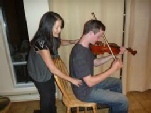 Keep the head + neck in good alignment with the rest of the body and not bent or twisted to one side.
Keep the head + neck in good alignment with the rest of the body and not bent or twisted to one side.
Sit directly facing others in the group where needed,
The weight of an instrument should be supported, where possible, rather than being held continuously by the arms.
Keep the shoulders relaxed and keep the elbows as close to the sides if possible.
Keep the wrist in a neutral position when viewed from above or the side.
Wear loose clothing to allow movement of limbs + body.
Grip the instrument ‘lightly’ and only press as much as is needed to play notes.
Take adequate rests between tunes.
Take care when manually handling, moving or carrying heavy / bulky instrument + cases.
Bend with the back straight and use the legs to do the lifting.
The causes of i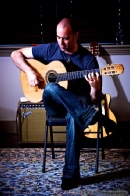 njury include poor playing posture (static + dynamic), poor seating, poor technique (grip, forces being used, angle of hands/wrists), repetitive movements and prolonged play without rest, personal stress level (tension) and risks carried over from their normal home + workplace - like working with computers.
njury include poor playing posture (static + dynamic), poor seating, poor technique (grip, forces being used, angle of hands/wrists), repetitive movements and prolonged play without rest, personal stress level (tension) and risks carried over from their normal home + workplace - like working with computers.
Prevention is better than the cure.
- Be aware of would injure you. Check that your instrument set up and your playing technique are optimal.
- Warm your body up by stretching and ‘activating’ the muscles used when playing.
- Take suitable rest breaks - move + stretch between tunes.
- Avoid getting excessively tired!!
- Practice regular stretching, core stability and strengthening exercises. Get strong + develop muscle endurance.
- Avoid slouched postures - bent forwards, leaning sideways or twisted to one side.
- Avoid twisting in your seat to face the group
- Do not excessively curl your wrist or overstretch the fingers. Avoid anything too tight around the wrist
- Do not grip or squeeze the instrument too tightly
- Use good playing technique
- Don’t ignore discomfort and pain
- Seek early treatment from your doctor, or from us here at Ennis Physio Clinic
‘Get Fit to Play’
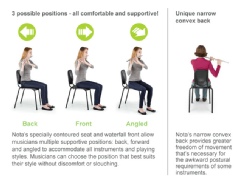
Irish dancing is a great form of healthy exercise for everyone and can be enjoyed by young and old.
Just as in sport, dancers need to know how to protect themselves from injury. Competition dancing requires a short intense period of dance but many hours of training, whereas set dancing involves longer periods of continuous moderate activity. The body of the dancer needs to be trained to undertake this safely.
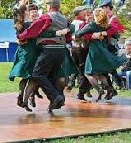 Irish dancing needs a combination of flexibility, strength + endurance, core stability and balance.
Irish dancing needs a combination of flexibility, strength + endurance, core stability and balance.
Significant flexibility for the trunk and the lower limbs is needed for some steps – high kicks and the ‘rocks’ and ‘on toe’ step.
Competitive Irish Dancers do not have movement of the arms – but set dancing does include arm movements.
Significant strength is required in the calf, hip and core muscles for the jumping + hopping used in some steps.
Training for competitive dance can involve many hours of daily practice so a good base fitness and endurance are necessary.
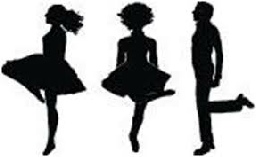
Core stability, strength and balance help to maintain good posture during performances, especially when standing on one leg and transitioning between steps.
Good technique needs good muscle control, core stability, balance and co-ordination - all of which will help to minimise injury to the feet and knees.
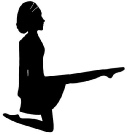
- The best way to avoid injury when performing Irish Dancing is to be well prepared.
- Be well trained with a good mix of baseline fitness, a strong ‘core’ and strong leg muscles.
- Do an appropriate warm up before dancing and a warm down afterwards. Warm ups should include some light aerobic activity (like jogging on spot), ‘dynamic’ stretching using movement (like swinging a straight leg to stretch hamstrings) and some step drills, which build up in speed and intensity towards performance levels. Warm down should include ‘static’ stretching of the muscles used during dancing and gentle aerobic activities.
- Monitor potential ‘hot spots’ in the bones of the lower limbs - bone aching indicates overloading of the bones and and this needs you to reduce the total time spent dancing time in order to allow adequate recovery.
- Running, swimming or walking are all good methods of ‘cross training’ to enhance overall aerobic fitness and endurance.
- Having correct foot postures, excellent step + landing technique and ankle stability are all important for avoiding leg and foot injury.
- Good dancing shoes will also protect the feet and legs.
- Heavy stamping on the floor may aggravate bone and joint injury.
Don’t ignore pain and discomfort during or after dancing - seek early advice from your Doctor or from Ennis Physiotherapy Clinic so that you can get back to being
‘Get Fit to Dance’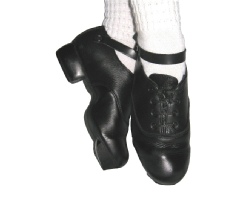
Common injuries in Irish Dancing are associated with overloading of the tissues during training and performance.
These include ligament and joint sprain in the foot, calf muscle strains and bone stress (fractures) injuries of the feet, shin and knees.
There is particular risk of overloading in actively growing children especially in the lead up to competitions when daily practice increases dramatically.
Certain steps (Rock Step, on toe and jumps) carry a high risk of injury. Poor step technique increases the risk of injury. Stamping the floor with the foot may cause impact injuries in older dancers.
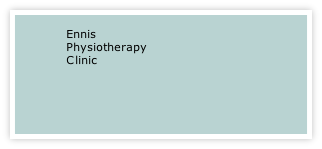




Mon - Fri 9.30am - 8.30pm


3A Barrack Close, Barrack St., Ennis, Co. Clare V95 X437

065 6840757
| Health+Safety Services |
| Sports Clubs+Teams Services |
| Standing Posture |
| Sitting Posture |
| Childhood Posture |
| Using Portable Devices |
| Normal Walking |
| Running |
| Running Drills Videos |
| Muscle Energetics |
| General Fitness |
| Losing Body Weight |
| Gaining Body Weight |
| Weight Loss Programmes |
| Start to Run |
| Start to Swim |
| Start Cycling |
| Start Nordic Waliking |
| Rehab of Tensdons |
| Loading of Tendons |
| Non Specific LBP |
| Posture |
| Intervertebral Disc |
| LBP Treatment |
| Non Specific Neck Pain |
| Neck Care Advice |
| Hamstring Strain |
| Ankle Sprain |
| ACL Injury |
| Joint Replacement |
| Shoulder Dislocation |
| Tennis Elbow |
| Wrist fracture |
| Fractured Knuckle |
| Selecting a Racquet |
| Racquet Grip Size |
| Racuet Sport Injuries |
| Training for Racquet Sports |
| Ski + Board Injuries |
| Injury Videos |
| Injury Prevention |
| Preventing Injury in Musicians |
| Irish Dancing |
| Preventing Dance Injury |